Tamale
A tamale is a traditional Mesoamerican dish, made of masa or dough (starchy, and usually corn-based), which is steamed in a corn husk or banana leaf.[1] The wrapping can either be discarded prior to eating or used as a plate. Tamales can be filled with meats, cheeses, fruits, vegetables, chilies or any preparation according to taste, and both the filling and the cooking liquid may be seasoned.
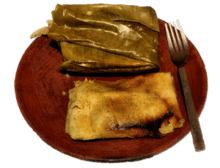 Wrapped and unwrapped tamales oaxaqueños (from Oaxaca, Mexico) filled with mole negro and chicken | |
| Course | Main course |
|---|---|
| Place of origin | Mesoamerica |
| Region or state | North America |
| Main ingredients | Corn (maize) masa, banana leaves |
| Variations | Corn husks |
| Similar dishes | Humitas, pamonha |
Tamale is the anglicized version of the Spanish word tamal (plural: tamales, from Nahuatl languages: tamalli).[2] Tamal comes from the Nahuatl word tamalli[3] via Spanish where the singular is tamal and the plural tamales. The word tamale is a back-formation of tamales, with English speakers assuming the singular was tamale and the plural tamales.[4]
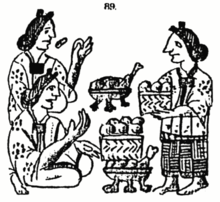
Origin
Tamales originated in Mesoamerica as early as 8000 to 5000 BC.[1]
The preparation of tamales is likely to have spread from the indigenous culture in Mexico and Guatemala to the rest of Latin America. According to archaeologists Karl Taube, William Saturn and David Stuart, tamales may date from the year 100 AD. They found pictorial references in the Mural of San Bartolo, in Petén, Guatemala.[5]
The Aztec and Maya civilizations, as well as the Olmec and Toltec before them, used tamales as easily portable food, for hunting trips, and for traveling large distances, as well as supporting their armies.[1] Tamales were also considered sacred as it is the food of the gods. Aztec, Maya, Olmeca, and Tolteca all considered themselves to be people of corn and so tamales played a large part in their rituals and festivals.[6]
Mexico
Pre-Columbian Mexico
Pre-Columbian Mayas
In the pre-Columbian era, the Mayas ate tamales and often served them at feasts and festivals.[7] The Classic Maya hieroglyph for tamales has been identified on pots and other objects dating back to the Classic Era (200–1000 CE), although it is likely they were eaten much earlier.[8] While tortillas are the basis for the contemporary Maya diet, there is remarkably little evidence for tortilla production among the Classic period Maya. A lack of griddles in the archaeological record suggests that the primary foodstuff of the Mesoamerican diet may have been the tamale, a cooked, vegetal-wrapped mass of maize dough.[9] Tamales are cooked without the use of ceramic technologies and therefore the form of the tamale is thought to predate the tortilla.[10] Similarities between the two maize products can be found in both the ingredients and preparation techniques and the linguistic ambiguity exhibited by the pan-Mayan term wa referring to a basic, daily consumed maize product that can refer to either tortillas or tamales.[11]
Aztecs
In the pre-Columbian era, the Aztecs ate tamales with fillings such as turkey, flamingo, frog, axolotl, pocket gopher, rabbit, fish, turkey eggs, honey, fruits, squash, and beans, as well as with no filling.[12] Aztec tamales differed from modern tamales by not having added fat.[12]
One of the most significant rituals for the Aztecs was the feast of Atamalcualiztli (eating of water tamales). This ritual, held every eight years for a whole week, was done by eating tamales without any seasoning, spices, or filling which allowed the maize freedom from being overworked in the usual tamale cooking methods.[13]
Modern Mexico
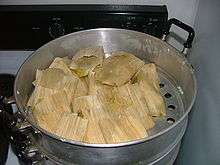
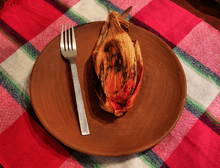
In Mexico, tamales begin with a dough made from ground nixtamalized corn (hominy), called masa, or alternatively a rehydrated masa powder, such as Maseca. It is combined with lard or vegetable shortening, along with broth or water, to bring the dough to the consistency of a very thick batter. It's traditional to whisk the lard, and whisk the resulting batter, with the intent of producing the signature soft and fluffy texture. Modern recipes may use baking powder to achieve a similar effect. Chili purees or dried chili powders are also occasionally added to the batter, and in addition to the spice can cause some tamales to appear red in color. Tamales are generally wrapped in corn husks or plantain leaves before being steamed, with the choice of husk depending on the region. They usually have a sweet or savory filling and are usually steamed until firm.
Tamale-making is a ritual that has been part of Mexican life since pre-Hispanic times, when special fillings and forms were designated for each specific festival or life event. Today, tamales are typically filled with meats, cheese or vegetables, especially chilies. Preparation is complex, time-consuming and an excellent example of Mexican communal cooking, where this task usually falls to the women.[14] Tamales are a favorite comfort food in Mexico, eaten as both breakfast and dinner, and often accompanied by hot atole or champurrado and arroz con leche (rice porridge, lit. rice with milk) or maize-based beverages of indigenous origin. Street vendors can be seen serving them from huge, steaming, covered pots (tamaleras) or ollas.
Instead of corn husks, banana or plantain leaves are used in tropical parts of the country, such as Oaxaca, Chiapas, Veracruz, and the Yucatán Peninsula. These tamales are rather square in shape, often very large—15 inches (40 cm)—and these larger tamales are commonly known as "pibs" in the Yucatán Peninsula. Another very large type of tamale is zacahuil, made in the Huasteca region of Mexico. Depending on the size, zacahuil can feed anywhere between 50 and 200 people; they are made during festivals and holidays, for quinceañeras, and on Sundays to be sold at the markets.[15][16]
Guatemala
Pre-Columbian Guatemala
In the classical times of the Maya of Central America (Guatemala in particular), the great Mayan lords delighted in a baked dough bun during the winter solstice, made of maize mixed with turkey, tepezcuintle (Lowland Paca) or venison, spices, and chili pepper, among other ingredients.
This meal was later integrated into modern Guatemalan traditions. For example, on Christmas Eve, families prepare black, red or sweet tamales for family and friends to show gratitude. The tamales are often accompanied with chocolate, yolk bread and punch, and participate in the Mass of Gallo, at Midnight.
It is customary in Guatemala to eat tamales at midnight on December 24 and 31. Guatemalans also use tamales for holiday celebrations, birthdays and baptisms, so the tamale is considered an important dish in the culture of Guatemala.
Guatemala has many tamale varieties from the traditional corn husked tamale (called a chuchito in Guatemala) to a sweet version of tamale, which uses the same corn dough, but it is seasoned with a honey or sugar combined with chocolate, almonds, plums, seeds and peppers. Tamales are sold all over Guatemala in stores and private homes (especially on Saturdays). A red light on a home at night is a sign that Tamales are for sale at that home.[17]
Varieties
- Guatemalan Tamale
Red Tamales They owe their name to achiote and tomato, made with corn dough stuffed with recado rojo, raisins, chili peppers, chicken, beef or pork wrapped in banana leaves.
- Cambray Tamales
They contain raisins and almonds, sweet tamales filled with sweet recado rojo, black tamales are named after the color that chocolate gives them, chipilin tamales wrapped in corn husks, parrot tamales, corn tamales among others are also made. Cream tamales and cheese and anise seeds are also mixed with corn tamales.
- Chuchito
The chuchito is a typical and emblematic dish of Guatemala. It is a variation of the tamale made with corn dough but a firmer consistency, although it can be added or added, lard to the dough to generate a more pleasant taste and consistency; and it is usually mixed with recado rojo of tomato and with a filling that can be with chicken, beef or pork, and wrapped with dried cob leaves (tusa or bender). In some places it is accompanied by cheese, sauce or both.
- Rice tamales
This variation comes from the Guatemalan highlands, where the typical corn dough is replaced by a thick dough of annealed rice with water and salt. The preparation of the recado rojo does not differ much from the original, since only in some regions will the ingredients with which it
- Paches
A Tamale made, particularly in the highlands of Guatemala, that uses potato instead of maize for the dough.
- Tamal or Tamalito
A tamal or tamalito is dough only, with no meats or other fillings. This dish is used to accompany a meal and used to scoop of food on the plate, or just eaten plain along with the main dish.
Belize
The tamale is a staple in Belize, where it is also known by the Spanish name dukunu, a green corn tamale.[18]
Caribbean
Cuba
In Cuba, before the 1959 Revolution, street vendors sold Mexican-style tamales wrapped in corn husks, usually made without any kind of spicy seasoning. Cuban tamales being identical in form to those made in Mexico City suggests they were brought over to Cuba during the period of intense cultural and musical exchange between Cuba and Mexico, between the 1920s and 2000s.
A well-known Cuban song from the 1950s, "Los Tamalitos de Olga", (a cha-cha-cha sung by Orquesta Aragón) celebrated the delicious tamales sold by a street vendor in Cienfuegos. A peculiarly Cuban invention is the dish known as tamal en cazuela, basically consisting of tamale masa with the meat stuffing stirred into the masa, and then cooked in a pot on the stove to form a kind of hearty cornmeal porridge.[19]
Trinidad and Tobago
In Trinidad and Tobago, it is called a pastelle and is popular in many households during the entire Christmas Season and New Year Celebrations. It is usually made with cornmeal and filled with cooked seasoned meat (chicken and beef being the most popular), raisins, olives, capers and other seasonings. The entire pastelle is wrapped in a banana leaf, bound with twine and steamed. When fully cooked, the banana leaf is removed to reveal the brightly yellow colored dish. It is often indulged as is or along with a meal. The sweet version is called paymee.[20]
United States
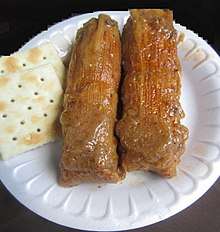
Tamales have been eaten in the United States since at least 1893, when they were featured at the World's Columbian Exposition.[21] In 1894, when tamales were the most popular ethnic food in Los Angeles, XLNT started making them. The company is the oldest continuously operating Mexican food brand in the United States, and one of the oldest companies in Southern California.[22]
A tradition of roving tamale sellers was documented in early 20th-century blues music.[21] They are the subject of the well-known 1937 blues/ragtime song "They're Red Hot" by Robert Johnson.
While Mexican-style and other Latin American–style tamales are featured at ethnic restaurants throughout the United States, there are also some distinctly indigenous styles.
Choctaw and Chickasaw make a dish called banaha which can be stuffed or not (plain) usually the filling (range from none, fried bacon, turkey, deer, nuts, and vegetables like onions, potatoes, squash, and sweet potatoes) can either be filled or mixed with the masa and steamed in a corn shuck.
Cherokee tamales, also known as bean bread or "broadswords", were made with hominy (in the case of the Cherokee, the masa was made from corn boiled in water treated with wood ashes instead of lime) and beans, and wrapped in green corn leaves or large tree leaves and boiled, similar to the meatless pre-Columbian bean and masa tamales still prepared in Chiapas, central Mexico, and Guatemala.
In the Mississippi Delta, African Americans developed a spicy tamale made from cornmeal (rather than masa), which is boiled in corn husks.[21][23][24] In northern Louisiana, tamales have been made for several centuries. The Spanish established presidio Los Adaes in 1721 in modern-day Robeline, Louisiana. The descendants of these Spanish settlers from central Mexico were the first tamale makers to arrive in the eastern US. Zwolle, Louisiana, has a Tamale Fiesta every year in October.
Around the beginning of the 20th century, the name "tamale pie" was given to meat pies and casseroles made with a cornmeal crust and typical tamale fillings arranged in layers. Although characterized as Mexican food, these forms are not popular in Mexican American culture in which the individually wrapped style is preferred.[25]
The Indio International Tamale Festival held every December in Indio, California, has earned two Guinness World Records: the largest tamale festival (120,000 in attendance, Dec. 2–3, 2000) and the world's largest tamale, over 1 foot (0.3 m) in diameter and 40 feet (12.2 m) in length, created by Chef John Sedlar. The 2006 Guinness book calls the festival "the world's largest cooking and culinary festival".
Philippines and Guam
_1.jpg)
In the Philippines and Guam, which were governed by Spain as a province of Mexico, different forms of "tamales" exist. Some are made with a dough derived from ground rice and are filled with seasoned chicken or pork with the addition of peanuts and other seasonings such as sugar. In some places, such as the Pampanga and Batangas provinces, the tamales are wrapped in banana leaves, but sweet corn varieties from the Visayas region are wrapped in corn husks similar to the sweet corn tamales of the American Southwest and Mexico. Because of the work involved in the preparation of tamales, they usually only appear during the special holidays or other big celebrations. Various tamal recipes have practically disappeared under the pressures of modern life and the ease of fast food. Several varieties of tamales are also found in the Philippines. [26][27][28]
Tamales, tamalis, tamalos, pasteles, are different varieties found throughout the region. Some are sweet, some are savory, and some are sweet and savory. Mostly wrapped in banana leaves and made of rice, either the whole grain or ground and cooked with coconut milk and other seasonings, they are sometimes filled with meat and seafood, or are plain and have no filling. There are certain varieties, such as tamalos, that are made of a sweet corn masa wrapped in a corn husk or leaf. There are also varieties made without masa, like tamalis, which are made with small fish fry wrapped in banana leaves and steamed, similar to the tamales de charal from Mexico, where the small fish are cooked whole with herbs and seasonings wrapped inside a corn husk without masa. The number of varieties has unfortunately dwindled through the years so certain types of tamales that were once popular in the Philippines have become lost or are simply memories. The variety found in Guam, known as tamales guiso, is made with corn masa and wrapped in corn husks, and as with the Philippine tamales, are clear evidence of the influence of the galleon trade that occurred between the ports of Manila and Acapulco.[29][30][31][32][33]
See also
References
- Daniel., Hoyer (2008). Tamales (1st ed.). Salt Lake City, Utah: Gibbs Smith. ISBN 9781423603191. OCLC 199465927.
- "tamale". English–Spanish Dictionary. WordReference.com. Retrieved 2016-02-26.
- "nacatamal". Real Academia Española. Retrieved 2018-04-08.
- "Origin and Meaning of Tamale". Online Etymology Dictionary. Retrieved 25 November 2018.
- William A. Saturno, Karl A. Taube and David Stuart 2005 The Murals of San Bartolo, EI Peten, Guatemala, Part 1: The North Wall. Ancient America, Number 7. Center for Ancient American Studies, Barnardsville, NC.
- Clark, Ellen Riojas; Tafolla, Carmen (2011). Tamales, comadres and the meaning of civilization : secrets, recipes, history, anecdotes, and a lot of fun. San Antonio, TX: Wings Press. ISBN 9781609401344. OCLC 714645014.
- LeCount, Lisa J. (December 2001). "Like Water for Chocolate: Feasting and Political Ritual among the Late Classic Maya at Xunantunich, Belize". American Anthropology. 103 (4): 935–953. doi:10.1525/aa.2001.103.4.935.
- Staller, John Edward; Carrasco, Michael (2010). Pre-Columbian Foodways: Interdisciplinary Approaches to Food, Culture, and Markets in Ancient Mesoamerica. New York: Springer. pp. 349–354. ISBN 978-1-4419-0470-6.
- Taube, K. A. (1989). The maize tamale in Classic Maya diet, epigraphy, and art. American Antiquity, 54(1), 31-51.
- Zizumbo-Villarreal, D., Flores-Silva, A. & Colunga-García Marín, P. (2012). The Archaic Diet in Mesoamerica: Incentive for Milpa Development and Species Domestication. Economic Botany, 66(4), 328-343.
- Taube, K. A. (1989). The maize tamale in Classic Maya diet, epigraphy, and art. American Antiquity, 54(1), 31-51.
- Olver, L., ed. (2000). "FAQs: Aztec, Maya, & Inca foods and recipes". Food Timeline. Retrieved August 30, 2012.
- Manuel., Aguilar-Moreno (2007). Handbook to life in the Aztec world. Oxford: Oxford University Press. ISBN 9780195330830. OCLC 81150666.
- Lawson Gray, Andrea (Jan 28, 2016). "Mexican foodways: Tamales and Candlemas". My Mission: Tastes of San Francisco.
- "Mexican tamale called the zacahuil is three feet long". Puerto Vallarta News. 2014-09-15. Retrieved 2017-07-26.
- "El Zacahuil, El Tamal Gigante de la Huasteca, La Ruta del Sabor, Axtla de Terrazas SLP" (in Spanish). ComidasDeMexico. 2013-09-15. Retrieved 2017-07-26 – via YouTube.
- "Tamales de Guatemala". Recetas de Tamales (in Spanish). 4 April 2019.
- Ken Albala (31 May 2011). Food Cultures of the World Encyclopedia: [Four Volumes]. ABC-CLIO. p. 34. ISBN 978-0-313-37627-6. Retrieved November 20, 2012.
- Three Guys From Miami. "Cuban Tamal en Cazuela". Three Guys From Miami. Retrieved 27 January 2017.
- Ken Albala (25 May 2011). Food Cultures of the World Encyclopedia. ABC-CLIO. p. 300. ISBN 978-0-313-37626-9. Retrieved 4 August 2012.
- Zeldes, Leah A. (Dec 18, 2009). "The unique Chicago tamale, a tuneful mystery". Dining Chicago. Chicago's Restaurant & Entertainment Guide. Retrieved Dec 18, 2009.
- Arellano, Gustavo (2019-12-23). "The XLNT tamales go back 125 years, capturing nostalgia for Californians across the U.S." Los Angeles Times. Retrieved 2019-12-31.
- "Hot Tamale Trail – Tamales in the Mississippi Delta". Tamaletrail.com. 2011-08-26. Retrieved 2013-12-15.
- "Tamales, Another Treat from the Delta". All Things Considered. NPR. Retrieved 2013-12-15.
- Zanger, Mark H. (May 1, 2007). "Tamale pie". In Andrew F. Smith (ed.). The Oxford Companion to American Food and Drink. Oxford University Press. p. 581. ISBN 978-0-19-530796-2. Retrieved December 27, 2012.
- "Baki". Binisaya – Cebuano Dictionary and Thesaurus. Binisaya.com. Retrieved 8 September 2016.
- "Pintos (Cebuano Sweet Tamales)". Inato Lang. Retrieved 8 September 2016.
- "Binaki the Corn Cake from Cagayan de Oro City". AdventuringFoodie. Retrieved 8 September 2016.
- "Binaki Recipe". Panlasang Pinoy Recipes. Retrieved 8 September 2016.
- "Binaki". Hapagkainan. Retrieved 8 September 2016.
- "Pintos and Budbod Kabog: Best of North Cebu Pasalubong". Penfires. Retrieved 8 September 2016.
- "Biyaki". Philippine Food Illustrated. Retrieved 3 January 2019.
- "Mga Sangkap ng Bawat Uri ng Minatamis na Pagkain". Maranao Foods/Menu. Retrieved 3 January 2019.
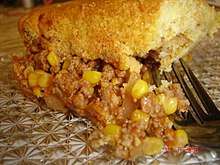
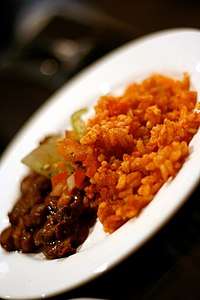

.jpg)

